“Surveillance is all about when people in authority know a lot about you. Instrumentation is when you know a lot about the world,” Cory Doctorow, Craphound.com, boingboing.net
When we spoke at the Virtual Worlds Forum in London last week, Cory Doctorow outlined a vision of how ways individuals tap into data and metadata to create instrumentation in “virtual” worlds might be thrown out into the “real” world to give people more agency there.
Cory D. turned my initial question inside out and gave a brilliant glimpse of something a little like Bruce Sterling’s idea for an Amazon.org. Amazon.org is a social software entity that can answer questions. Questions about our world. Questions about objects. “What questions? Not the profit-centric questions that obsess Amazon. The serious questions.” (Shaping Things)
“The Inverse of the Surveillance Society”
Me: What happens when Virtual Worlds become flooded with data from “real life” objects, geo- positioning, etc., and extreme life–logging enters virtual worlds?
Cory: Well this is like Spook Country the new Gibson novel – What happens when cyber space everts – hmmm? I’m not sure I have anything very pithy to say on that EXCEPT………
Apart from all the traditional kind of overlay reality stuff, if there is one thing I am actually interested seeing from a virtual world migrating to the real world its instrumentation.
I think lot of things that are characteristic of very successful internet based business is that they are extremely finally instrumented so like Amazon knows in aggregate on a second by second basis how their site is being used by people and they can twiddle the dials in real time.
As users of the world we have very little access to that kind of instrumentation. We don’t even know how the tube is running. The tube knows how the tube is running and we kinda of don’t. I would be really interested in seeing that. You’ve seen Joi Ito’s WoW interface right. Have you seen it …
Me: Ummm no! [But I have now. Joi Ito sent me a Flickr link to his photo. Thanks!]
Cory: When they are doing a raid at a certain point the number of instrument panels on his screen actually eclipses all of the vision of the raid you no longer actually see the raid. You are experiencing WoW through a purely numerical and data visualization system.
There are different abstraction layers at which you can experience the world and one of them is through the instrumentation of it. It is in some ways the inverse of the surveillance society.
Surveillance is all about when people in authority know a lot about you. Instrumentation is when you know a lot about the world. And it allows you have more agency. When people know a lot about you it takes away your agency.
Me: So is that on the lines of personalized virtual operation centers – like MySpace’s with instrumentation….?
I don’t have this fleshed out into a nice solid like a non abstract thing. But the thing that I have been noodling with is what if all the kinds of data visualization and aggregate statistical information about the world that big companies use in order to realize their enormous profit and control over us as individuals was in our hands.
This is a little like Bruce Sterling’s idea of an Amazon.org [see page 111 Shaping of Things] where all the data from the positional and temporal characteristics of all the objects that we own were in aggregate visible and available so that we can mix and match them remix them understand them and have more agency in the world.
I think that empiricism, measurement, understanding more about the world is the thing that the Enlightenment is grounded in. Like being able to write down how the world works using objective measurements being able to compare them with other people in terms of peer review and experimentation that is the core of what makes us contemporary human beings – post enlightenment, non alchemic, non superstitious, empiricism grounded people.
Being able to understand what is going on the world – How much RFI is there right now where I am standing? What frequencies is it running on? What are the aggregate histograms? Tell me about it. Are people looking at the web around here, or talking on their phones, or sending SMS? Am I in a spot where the thermal signature of lots of people is high or low? What was it like ten minutes ago? Is this typical or atypical of the characteristic histogram of thermal and electromagnetic energy in this space for this time, year on year, day on day, and hour on hour?
Just knowing that and knowing it on some liminal way where your clothes feel different based on whether the room is typical or atypical. That is a really interesting thing to know.
Games do this all the time. You know a lot about the way the game is performing by things like audio cues, like coloring cues, Also by cues that have to do with network jitter. You hop onto a shard with like a zillion people on it that shard performs differently. You don’t know when you walk into a room necessarily what the activity level in that room is, especially if it is a room subdivided by a lot of physical baffles and things that hide what is going on from you. But you know when you walk onto shard whether it is an active or inactive shard.
So can we grab all that stuff that lets us know a lot about the virtual world and exert agency over and influence over it and throw it into the “real” world.
That what be very cool.
A Global Virtual Worlds Open Source Community
Open Standards are frequently cited as a key part of what will make virtual worlds “fit for business.” But for a reverse surveillance society where virtual operations centers could be universal information resources for all of us open sourcing and open standards are also the key to tapping into the myriad data streams currently only available to business and government.
At the Virtual Worlds Forum in London the virtual worlds open source community was not on one panel together. But they were a small but noticeable cohort that caught my attention.
Of particular note was the presence of Adam Frisby of OpenSim, Adam Johnson of 3Di and Bjorn Lee of HiPiHi. HiPiHi and 3Di are both funded by the ngi group, Inc. And 3Di are developing a virtual worlds platform Jin-sei based on OpenSim. 3Di is now in a partnership with Mixi (the largest social networking site in Japan with over ten million users) developing virtual worlds on the Jin-sei platform. OpenSim is the BSD Licensed Open Source Initiative that has evolved from Second Life.
Some 3Di employees using Jin-sei
“3Di, Inc. believes its innovations will be the key to developing the new 3D Internet.”
The picture above shows the location of the 3Di offices in Tokyo – a location that may turn out to be significant.
3Di, Inc., a Tokyo based subsidiary of the Japanese holding company ngi group, Inc., aims to revolutionize the way virtual worlds and the web work together. 3Di, Inc., as an international company based in Japan, is uniquely positioned in the underdeveloped Japanese and Chinese markets to deliver language and culture sensitive solutions, while still maintaining a global perspective. 3Di, Inc. believes its innovations will be the key to developing the new 3D Internet.
Drivers of the 3D Internet:
Every time I saw Ian Hughes of IBM (far left) and Adam Frisby of OpenSim (next to Ian), Adam Johnson of 3Di, and Bjorn Lee of HiPiHi talking together. I couldn’t help thinking wow: “I am witnessing the team that will pioneer the 3D internet.”
So I decided to interview these four to who seemed to me to be already well on the way to being a global virtual worlds interoperability team.
While there were many interesting stories to tell at the Virtual Worlds Forum, I focused my attention on players who seemed to be weaving the following five virtual world threads together.
1) social networks 2) user generation 3) open source/standards 4) 3D immersive 5) social gaming
I also spoke to Ginsu Yoon, from Linden Lab. Linden Lab has been making interoperability and the movement to create open standards for virtual worlds a priority. But as Ginsu Yoon spoke from the podium on Linden Lab’s expansive vision for a 3D internet and podcasts will be available on the VWF site, I did not do an individual interview with him. But we spoke a couple of times. And I ran by Ginsu the direction of my thinking.
The essence of these chats was that the interoperability of virtual worlds would not come from top down from a “standards committee.” Rather standards of interoperability would be worked out from the bottom up by people coming together to actually work on the architecture, e.g. in groups like the Architecture Working Group that is attended by OpenSim, IBM, and many others.
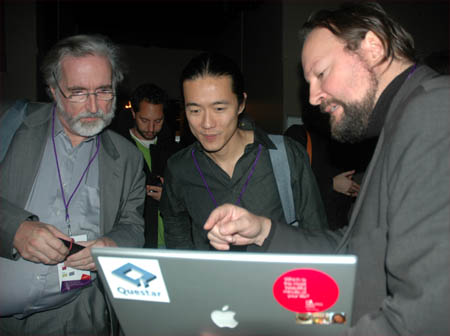
In the picture above David Orban shows a delighted Ginsu Yoon his new Second Life viewer an: “Immersive stereoscopic projection of a life size screen covering 180 degrees of vision, connected to the live grid, tracking the avatar with ultrawideband emitters, created by the University of Milan and Eximia, in Italy.” David has posted a video gives a full explanation of “Real 2nd Life” on his blog, so check it out!
Interview With Adam Johnson: Movable Life & 3Di
The picture above shows Steve Prentice of Gartner Research (famous for his quote earlier this year that “80% of active internet users will have a “second life” in the virtual world by the end of 2011″) talking with Adam Johnson of 3Di and Bjorn Lee of HiPiHi.
Me: Could you introduce yourself please Adam?
Adam: I’m Adam Johnson. I’m working for a 3Di a company based out of Japan. We have our own virtual world platform and web services between virtual worlds connecting them. The Capital company is called ngi Group. It’s the number one incubator company out of Japan. We started about four months ago and now we have a virtual worlds platform, Jin- Sei, which is based off the open source software OpenSim. We’re marketing that towards B-to-B right now. On the services side we have Movable Life, which is a web-based Ajax client for logging into Second Life through a browser or iPhone. We’re working on other mobile interfaces as well.
Me: Why did you think Movable Life and this OpenSim application got launched in Japan as opposed to here?
Adam: That’s a good question, I’m not really sure. I think because in Japan a lot companies are really starting to look at virtual worlds. Because in Japan everyone has the same notion that virtual worlds are just going to explode and probably in the near future be more popular than in other countries. Japan will be like a hub for Virtual Worlds, I guess.
Me: And how did you get involved because you’re obviously American.
Adam: I was working at ngi Group before actually. So I had been living in Japan for 2 years.
Me: ngi is the investment company?
Adam: Right. We’re fully owned by ngi Group – the incubator company.
Me: So you were working for the venture capitalist company?
Adam: I was working for another startup and then I just transferred when they started this company.
Me: So what’s your job title?
Adam: I’m Project Leader for Movable Life.
Me: Why did you choose OpenSim?
Adam: we were just looking for ideas on what open source tools there are already to get our own virtual world platform off the ground. The best one out there at that time was OpenSim so we decided to go full on with Open Sim and LibSL and get involved. So Movable Life is based on LibSL as well so we’re very involved with open source community.
Me: Is Movable Life open source?
Adam: Movable Life code is proprietary at the moment, but we’re looking at open sourcing that in the future.
Me: So what physics engine are you using for OpenSim?
Adam: For our platform Jin-sei, we’re currently using the open source ODE at the moment. But we’re looking at maybe going to Havoc in the future.
Me: I know in the Open Sim that we’re using only about half the scripting is implemented. Is that still the same with you?
Adam: Yes, but the core of the scripting engine is based on C-Sharp, it has a C-Sharp engine. For user scripting it’s about half implemented. But server side we can do C-Sharp full on.
Me: What can Movable Life run on?
Adam: It runs on the iPhone. So it’ll run on Safari, Firefox, Internet Explorer, or Opera, anything.
Me: How how far have you got in terms of making OpenSim a grid or making it interoperable with Second Life?
Adam: We’re doing a lot of performance testing now. And for Jin-sei we just have a partnership with Mixi where they’re going to be running private virtual worlds using our platform. They have more than ten million users. Mixi is Japan’s number one social networking site. My Space tried to go in there and they totally failed.
Me: That’s interesting!
Adam: The Mixi deal will at first be a limited private test for a certain group of Mixi users, just to get good data on how everything is performing. We have a lot of large companies that are really interested in using Jin-sei for several different things, private and public.
Adam: Right now I’m focusing on creating a virtual hub for all of the virtual worlds. This is my project. We have two different sides, we have our platform and then we have our Movable Life Hub.
Adam: Movable Life comes from LibSecondLife and right now that’ll connect you to Second Life, and soon to an OpenSim grid and Jin-sei.
Adam: The goal is in a few months we’ll have a new version coming out which will kind of merge all of them together. So you log into Movable Life and you’ll have a central portal to each virtual world. Movable Life is not a virtual world. It’ll be like a web service to combine them all. It’ll combine anything using OpenSim or Second Life, probably HiPiHi later on. We’re working with some Japanese companies as well for their virtual worlds. We want to connect all of them if possible.
Cory Doctorow and Bjorn Lee of HiPiHi
I recorded part of the conversation between Cory Doctorow, Bjorn Lee from HiPiHi and Adam Johnson of 3Di (with their permission of course!) about social networking in immersive virtual worlds versus social networking in less immersive spaces.
Raph Koster of Metaplace was not able to fly out of Southern California because of the wild fires so I couldn’t follow up on what had been an interesting debate on 2D versus 3D social networked spaces at the San Jose Virtual Worlds Conference and Expo. If Raph had been there I would have loved to ask him some questions about interoperability and Metaplace also. Ian Hughes of IBM talked with me about how Metaplace’s use of RESTful APIs will create many interesting possibilities. And I had a long conversation with Bruce Joy CEO of the newly launched Vast Park which potentially will be interoperable with Metaplace.
Cory D. on the place of social networking sites in an increasingly immersive 3D future?
In response to questions from Bjorn (HiPiHi) and Adam (3Di), Cory Doctorow argued persuasively why from a social networking point of view less immersive 2D spaces might hold their place alongside immersive virtual worlds. I turned on my iPod recorder mid-stream in the dialogue.
Cory: ………[re how to drop] a whole bunch of people you don’t like very much who’ve recruited you into their social circle. The best way to do it is to say oh you know I am just tired of Facebook. Not like you people all bother me. Its like I just not using Facebook anymore. You just stop logging in. That’s the reason not like deleting you account in a huff. Just kind of slowly disengage from Facebook. They can see you haven’t updated your Facebook in 6 months. You are just kinda not there anymore. Then you just delete your account and no-one cares anymore. That’s like a socially neutral way of disengaging from a group of people who you had to friend and who friended you.
The cost of blowing off your social network is pretty low because the value of your social assets which is the articulated social network of people you like is offset by the negative value of the articulated network that is wrong where you have named all these people as your friend.
In a virtual world the problem is confounded by the acquiring of assets that actually have real world monetary value whether that be a currency or objects that can be bartered for a currency. So blowing off you WoW account actually costs something. It has a monetary expense as well. Its not that people don’t do it. But they often do it on mass as the game gets less fun for some reason.
Like when SWG re-factored and it got less fun and everyone left. One of the things that contributed to that was WoW lit up and a whole bunch of SWG players said I’ll go and play WoW for a week and SWG was just kind of empty so the value of those assets blew up. So it cost less to leave SWG after SWG crashed and so people were willing to leave.
But if you have to wait until the game crashes before you can blow it off that means you have this complicated relationship where you have to remain friends with people you don’t like or abandon your virtual goals. That is a terrible conundrum to be in. I think there will be elements of this. But I don’t think that is going to take it all over.
Bjorn: My question was more about the fact that in a virtual world’s social networking site the main difference is a sense of place. Your have friends and you want to hang out in the Mall, for example, you can’t do that in a [2.D] social networking site. But a virtual world is like going to a Mall you can go there see who is there, hang out with people, you can use hand gestures, and communicate through text and sound…
So now that now technology has advanced to a stage whereby text based social networks on which you can just send pictures and videos are pretty primitive. Do you think this kind of social networking site will still be prevalent in the future?
Cory: So its a really interesting question. I think that we are typically pretty bad at evaluating the long term costs of our actions. This is one the big privacy problems. We sell our privacy very cheaply and subsequently regret it because it costs us a lot when we’ve sold our privacy. But we don’t find that out until one year or two years later. Or we buy DRM media and we don’t realize how much that cost us until it is time to throw out your iPod and buy a competing device right.
So I think people will be willing to migrate into social networks that are on games because I think it will be on crack. I mean all the monkey pleasure of laying out the pictures of all your friends and all the grinding pleasure of doing all that game stuff and all the cyber sex and all the rest of it. Its going to be like on crack.
But how many times will you going to be willing to do that. Cuz you are going to have to blow it off eventually. And are you eventually going to say to your self, “oh shit this sucks. I am bankrupting myself every eighteen months in order to escape the people I don’t like very much.” And that’s really tricky. I don’t know. I think that might leave a place intact for social networking sites.
Adam 3Di: What if you had different levels of privacy in virtual worlds where you could throw them into this group where they don’t get to see as much information on you.
Cory: Its very hard to prospectively evaluate the cost of adding someone to a friend list. That’s the problem. You have to know a priori to know what level of trust to assign to that friend to. Then you get into this thing, where people are like, “Am I on your A list, your B list, or your C list.” And you become one of these self obsessed terrible, obnoxious … you become one of these people who in 8th grade who had the list of good people, medium people, bad people, sub bad people. That’s not reflective of a natural social dynamic. Now it may in fact push back – its kind of a nightmare scenario – what if it does push back? What if that actually does become the organizing principle by which we establish our social relations in the “real” world. Are you an A person or B person for me? But I just kinda hope we don’t get that.
Interview with Adam Frisby about OpenSim
Adam Frisby discussing architecture? with Ian Hughes of IBM
Me: Please could you introduce yourself Adam.
Adam Frisbee: I’m the executive director of a company called DeepThink Labs. We’re an international company with people in the UK, US and Australia. I started off last year working on the LibSecondLife project which just basically built a protocol description of the Second Life protocol.
We’ve built a programming library from that which allows you to connect in third party applications into the Second Life grid. In early January, just after the Second Life Client source code was released, another developer called Michael Wright developed a piece of software called OpenSim, and I got involved in that pretty much as soon as I saw the announcement of it. And since then I’ve been working as one of the developers of the Open Sim project.
Me: What Physics Engines does OpenSim support?
Adam: Right now we support four. But we’ve got our own one called Basic Physics which is just a very very simple engine, it doesn’t do physics solving really. We’ve got a second one called ODE which is the Open Dynamics Engine that ngi is using right now. That one’s a fairly mature open source physics engine.
We also support Bullet. Bullet is a new type of open source physics engine designed by Erwin Coumans, who was a major developer on the Havok Physics engine, it’s new – but it has a lot of potential.
We also support something called PhysX. PhysX is a commercial physics engine like Havoc. Its about on the same scale. But it supports optional hardware acceleration so you can actually get an accelerator card, put it in your computer, and then you get the ability to use that to accelerate the physics that’s going on in that server.
Me: How do people get involved developing code for OpenSim?
It’s essentially a meritocracy. We look for good developers, who are submitting good patches, to the project and we invite them in to be permanent contributers. Right now the way the OpenSim project works is strictly by consensus. There’s about 9 people right now who’ve got a voice in the consensus. And whenever a decision needs to be made such as whether we add another person into the development team it has to be done exclusively through consensus. It can be a very interesting process when people disagree, but nonetheless that’s how we’re operating.
Me: Where do you meet?
We don’t meet inworld in Second Life anymore, we’ve moved to an opensim …..
The majority of the discussion happens pretty much in two places. The first place is our mailing list, that an email list the developers are welcome to subscribe to and then people send out long emails and get long winded replies back.The other way we communicate is over IRC which is Internet Relay Chat. We’ve got a channel on EFnet, and a lot of people hang around there. There’s about 60 people there all the time. Then there’s a secondary channel which is #opensim-dev which is all the developers and everybody interested in the development side of things. So it’s sort of broken up into the two groups, users in the one channel, and the developers in the other channel.
If you need help with getting it running then that’s the users channel. We split them up basically because we were trying to discuss technical topics and at the same time there was a collision with the people trying to get basic help.
So in the development channel we are discussing things like future architecture. If there’s a big decision that needs to be made and it’s brought up in the IRC channel then someone will go off and write that up to a mailing list as a post so those who weren’t there at the time, can go off and read what’s happening.
Me: Do you attend the Linden Lab Architecture Working Group?
We made an effort to actually attend those. That’s because Zero’s been discussing allowing the interconnects between the Second Life Grid and potentially third party servers like OpenSim. So of course being there is valuable if we want to make sure we are compatible with what the plan is.
He goes into very technical topics which is fantastic. And he’s willing to go into good depth on them. They are well worth attending if you’ve got any interest at all in things like protocol design. We had a great discussion once on the merits of parallel programming.
We have had a lot of benefits from Linden Labs experience by watching what has worked and what hasn’t. At the same time, what we’re working on is of course fundamentally very similar to what Linden Labs working on. In fact the architecture working group will probably produce something that’s going to be used by both Linden Labs and everyone else who wants to host a virtual worlds grid.
Right now we’ve got an opportunity to re-engineer and add scale to things. Second Life’s biggest flaw is that you can’t have an event with 5000 people in it. The grid just collapses and you can’t get all those people into a reasonable contiguous area. Whereas for OpenSim we can actually write a customized server that will actually support that by degrading certain things like physics. You degrade that down to a very low quality of physics. You turn off scripting, that kind of thing. You can customize a server to do something like that and Open Sim’s got the potential that hey Linden Lab can use it too and take advantage of these things.
Making more lightweight situations, removing central dependencies, that kind of thing.
We’re working with everything from a simple engine like Basic Physics to some of the most complex proprietary engines you can get, e.g., the PhysX one. It’s a very powerful engine.
It’s the opportunity to pick and choose what you want to use. Our key aspect is that everything is modular. You can take out any module and replace it with any other compatible module or even have no module at all. You can do that for scripting, for physics, everything down to instant messaging and chat are all modules, so you can chop them out.
Me: Will there be any problems of interoperability with the Second Life physics engine?
I think it will fine. It’s not such a big deal. We can always write a module to implement the Second Life physics engine. The Havoc caveat. They’re talking about implementing Havoc 4. We’d just implement that as another module. And suddenly we’d suddenly support 5 different engines.
Me: And what about assets and interoperability?
Assets aren’t too bad either, the interoperability issue is protocols. Simply speaking the same language. We’ve got the protocols from the client to the simulator. What we don’t have is from the simulator to the grid. That’s the language we’ve got to learn to be able to connect to the Linden Lab infrastructure.
It’s on the plan. The Architecture Working Group is actually devising a new language. But we don’t have the current language. That’s why you can’t connect to an Open Sim to the existing grid.
Our grid infrastructure is running on our own one. But that’s going to disappear and be replaced as soon as we’ve got something better which is what the Architecture Working Group will produce.
We will use the best new protocol thinking from every idea everywhere.
Interview with Ian Hughes, IBM (a.k.a Epredator Potato)
Picture above shows Epredator getting involved with a CSI: NY in Second Life at csiny orientation west95
Ian Hughes was one of the early pioneers for IBM in Second Life, particularly in the area of “virtual” and “real” integration, including the IBM Wimbledon project in Second Life. I asked Ian to talk about the early days linking First Life and Second Life.
In all the virtual world stuff there’s initially a feeling that it’s somewhere you go, and the emotional attachment is that it’s somewhere else. And even with Second Life, it’s called Second Life, it’s somewhere else.
From day one for me I wanted to know whether I could do the same things in the same way as we do on the web, where we’ve gone with mashups and in terms of SOA (Service Orientated Architecture) is to say I’m over here at the moment but all my stuff’s over there, can I get it there? That works both personally and at a business level.
And just knowing that there’s any channel to go from one place to another is no matter how small as long as it’s bi-directional even if it’s only a few bits flowing you know that that channel’s going to get bigger, it’s going to get faster, and it’s going to get more standardized.
So from day one it was, “great can I control a second life object from outside?” And that was before the http stuff in Second Life. It was just yes of course I can. But you have to actually do it. So I made a light switch. No big deal a light switch. That was just sending a message in. That was just one line of code. and its one line of code any techie would do and many techies has done the same. But I also wanted to know if could demonstrate messaging and flow within the environment in a publish/subscribe way. [Ian did explain how he accomplished this].
This was 18 months ago or it might be 19 months ago, March – April time. [This early work on messaging and message brokering in Second Life Ian explained was very helpful in introducing Second Life to other IBMers. ]. We had this thing which was turning a light on which was now responding to an external message. Roo augmented that so that a message from Roo’s laptop when it gets tilted was being injected into Second Life. Roo built a laptop on a gimble so that when you tilted his laptop in Real Life it would tilt the Second Life one.
Now in any demonstration where you say “here’s this quirky virtual world and isn’t it funny” now let me just pick my laptop up – you’ve caught them out – you’d pick the laptop up and the one on the screen would tilt. Controlling a virtual object like that is no big deal now. But it’s got a whole lot of messaging stuff underneath. And it was our core technology concept from Hursley that was being used.
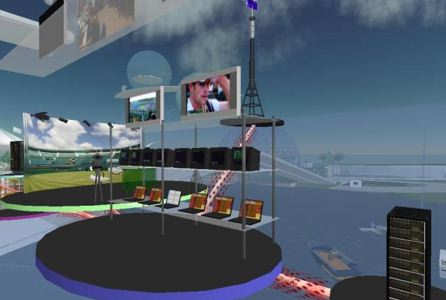
Behind the scenes at Wimbledon in Second Life
That became sort of an iconic moment for us that we’d achieved that. We’d got all the bits so that we then knew that we could get further with Wimbledon having more data and more stuff and more instrumentation coming from the real world. So that’s when they [Linden Lab] opened up their http request APIs which they did just before Wimbledon luckily. I knew that I was going to be able to start to represent things in the virtual world in a way that we’d never got around to before. And I knew we could get buy-in from customers. And, I could get buy-in from other IBMers because it was Wimbledon.
My own Hursley Island rapidly went from a small plot of land to multiple IBM islands. Some of this [rapid growth] was just telling everyone that we were doing it. We were writing internally on blogs to our fellow early adopter people. I was reaching an audience particularly with Wimbledon.

Jessica Qin, IBM, builder/scripter/evangelist
In sharing that meant other people started to come to us. So thats when we met people like Jessica Qin. She had been in Second Life for years, living there and having an existence there but not in a work context originally. We kind of found them [IBMers around the world]. We realized we’re trying this stuff at the same time and that was good so we immediately had gone across the pond and further.
Then again lots of people suddenly started to turn up and the core people, a lot of the people who are here at VWFE, are the ones who were there at the start. And that formed this little community and it started off with 2 people and then 10 people and by November 2006 it turned into 3,000 people. It was a bottom up process. Now it is over 5000.
Virtual Control Centers as a Mass Phenomena?
At the Virtual Worlds Forum in London last week putting the kinds of data visualization and aggregate statistical information about the world that big companies use in our hands didn’t seem too far off when you listened in on some of the “off stage” discussions
I blogged in my previous post that Eolus One is developing what I thought might be the first major business application using OpenSim. Eolus I wrote is developing secure virtual control centers for facilities management with sites on OpenSim. And, next on the table for development are plug and play modules based on the Eolus VWCI that will bring the kind of facility management now only possible in large scale facilities into every home.
In the picture below Oliver Goh (on right) is showing the Eolus Virtual World Communication Interface to Sara de Freitas the Serious Games Institute (center and holding the Eolus VCWI), Adam Johnson of 3Di (on the left) and Bjorn Lee of HiPiHi (standing under the chandalier).
Old Media & Big Business Enter “The People Age.”
At the Virtual Worlds Forum, “old” industry/media was often indistinguishable from the new user generated, socially networked/gaming, 3D immersive, open standards, interoperable generation as we stood and chatted under the lights of the gilded chandeliers in the bar, or sat in alcoves on comfy couches streaked by color from disco lights.
In the picture below from left to right Dolf Wittkamper, Senior Director, Philips Design, Chris Carella Chief Creative Officer, Electric Sheep Company, Oliver Goh, Paradigm Engineer for Implenia Global Solutions, and Giff Constable, VP of Electric Sheep Company’s software practices. They were logging on to the CSI:NY sims that had just opened to the public.
The VWF venue was an old night club/roller disco near Kings Cross that London cabbies seemed to call The Potato Market. It seemed an awful lot like Second Life at times. And Delé Atanda, Global Digital Marketing Business Partner, Diageo, pointed out the virtualness of this space that is soon to be demolished to make way for some Eurotowers? I interviewed both Delé Atanda and Dolf Wittkamper at the VWF. I will cover these interviews and the very interesting approaches to Second Life that both these companies have taken in conjunction with Rivers Run Red in an upcoming post.

The Rivers Run Red exhibition at VWF.
One of the highlights for me during VWF was chatting with Louise Jorden of Rivers Run Red (center in pic above) and Delé Atanda, Diageo in “real life” at The Hospital Club – one of RRR’s partners.
Delé and Dolf exemplify to me to corporate executives that understand that the future will not only blur the lines between the “virtual” and the “real” but also the distinctions between corporations and individuals. Traditional hierarchies are disintegrating leading to what Josephine Green, Director of Trends and Strategies for Philips, calls the “people age,” and Delé Atanda, Diageo, calls the “age of imagination.”
This age is characterized, as Joesphine Green points out, by “the decline in trust in institutions and leadership; people becoming increasingly empowered and creative about their own lives; a desire to co-create and produce their own experiences; the search for greater customization, personalization and autonomy.”
Del̩ Atanda presenting the Diageo Digital Workspace in Second Life Рdeveloped in conjunction with Rivers Run Red and IBM.

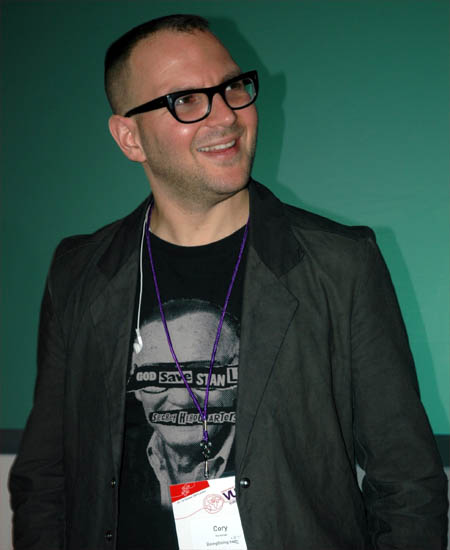
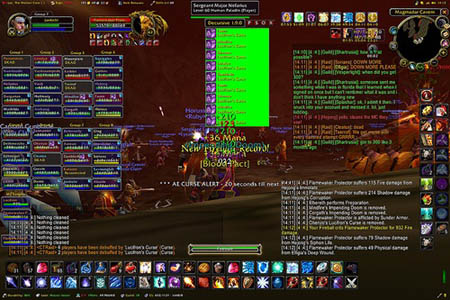
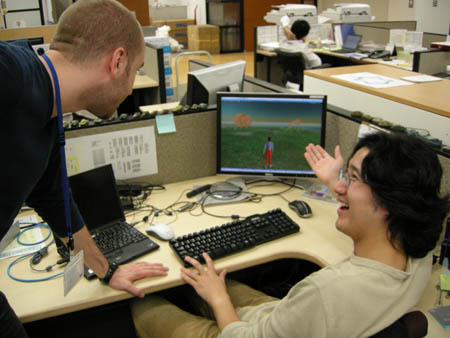
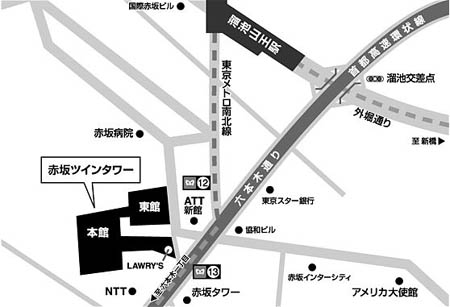
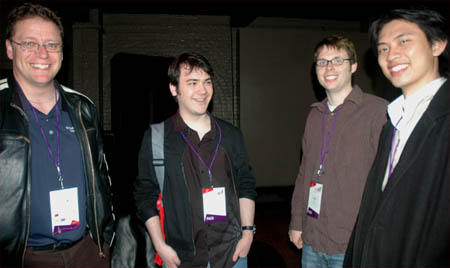
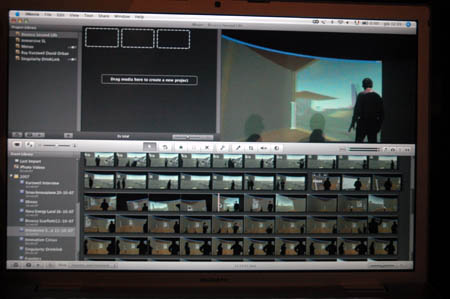
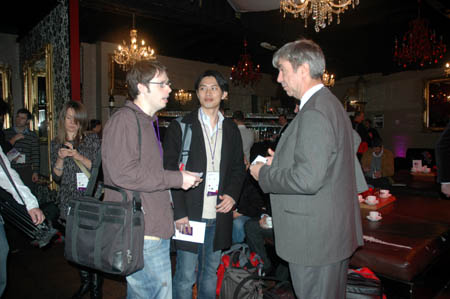
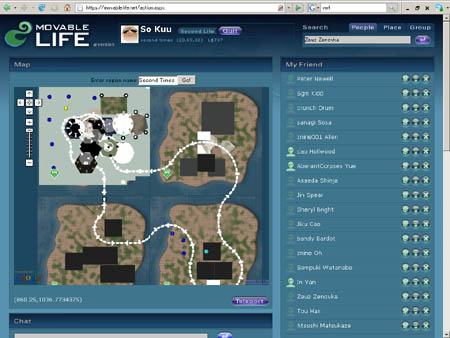
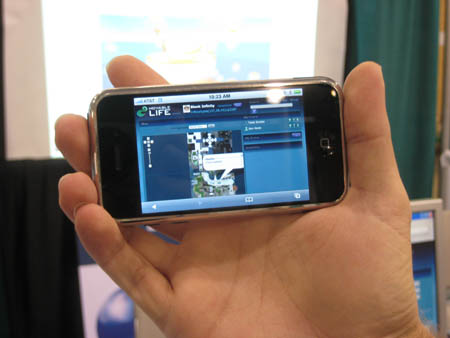

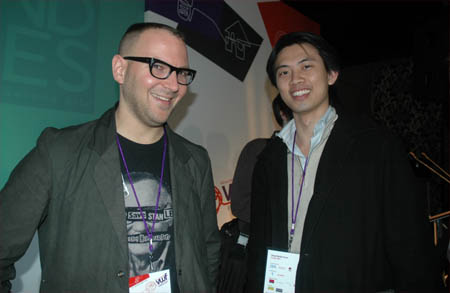
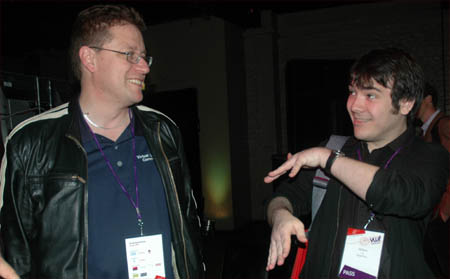
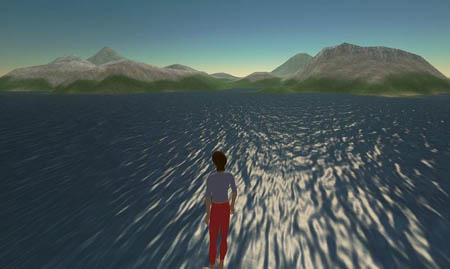
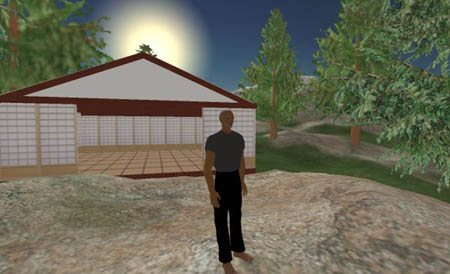
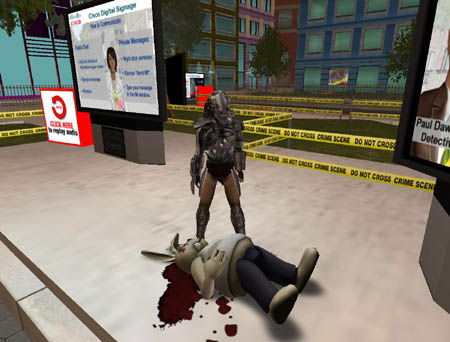

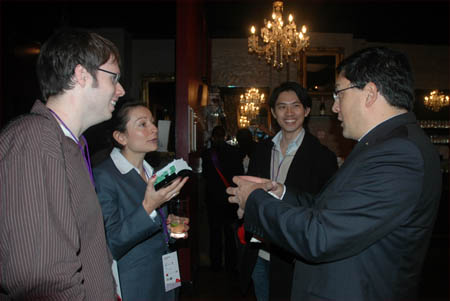
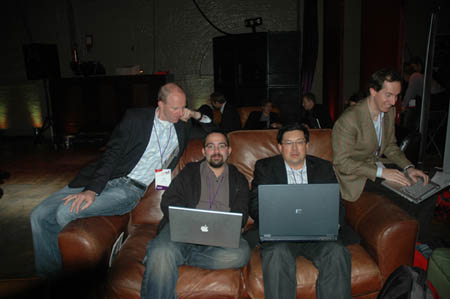
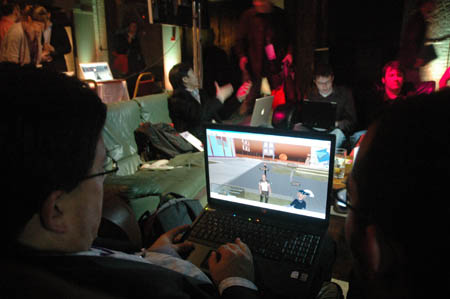
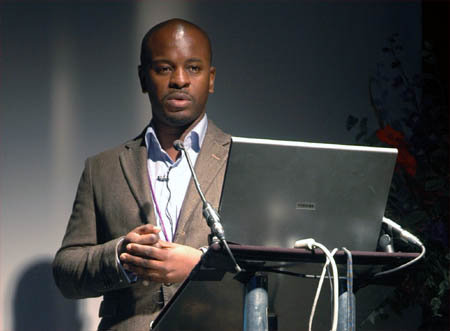
December 8th, 2007 at 11:02 pm
Hi Tara, you are tagged to blog 8 things about yourself– read the instructions at the bottom of this link:
http://nwn.blogs.com/nwn/2007/12/eight-hamlet-fa.html
E-mail me if/when you do, and I’ll link to it!